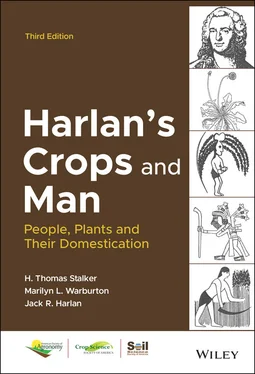The sharing rules may, in fact, cause the fragmentation of large camps. When a game animal is divided into so many shares that each person receives only a tiny scrap of meat, the better hunters are likely to fission off with their immediate families in order not to share with all. People may also resort to hiding personal items in order not to share. The social ideal of sharing freely has appeal, but seems to work best in small intimate groups.
Unharvested resources have a different set of rules. In many areas tribal territories are clearly defined, and even foraging microbands or families may be allotted specified regions, groves, or stands of useful plants. They very rarely harvest on land reserved for other bands. Springs and water holes may be owned by specified groups and the outsider must ask permission even to drink. This is true in both South Africa and Australia. In Australia, land ownership was respected during the burning season. It was considered a serious offense to burn another's foraging range. The time and place of a burn were carefully chosen and serious attempts were made to keep the fires within prescribed bounds (Warner, 1958).
If a pygmy finds a bee tree, he can mark it, and he alone is entitled to harvest the honey. To steal from a marked tree is a serious offense. Among Bushmen the same holds true for ostrich nests as well as bee trees and stealing either one can be punished by death. Some of the hollow trees of Bushmen ranges fill with water and provide an important source of water in a semidesert land. The trees may be individually owned and inheritance may pass from father to son (Marshall, 1960).
Tree marking is also observed in Australia (Gregory, 1886):
A native discovering a Zamia fruit unripe will put his mark on it and no other native will touch this; the original finder of the fruit may rest perfectly certain that when it becomes ripe he has only to go and fetch it for himself.
Property rights are demonstrated by the custom of breaking off the top of the “grass tree” ( Xanthorrea ), which will then rear large edible grubs. The one who breaks off the top owns the grubs that will be produced later (Grey, 1841).
At least one Aboriginal family is reported to have owned a rock quarry. The head of the family removed slabs of rock, broke them into appropriate pieces, and shaped them crudely as blanks from which ax‐heads could be made. The blanks and spears entered into the long‐distance trading routes established by the Aborigines long before European contact (Coon, 1971).
A number of tribes of the Pacific Northwest kept slaves. These were captured in raids on neighboring tribes, purchased, received as gifts in pot‐latch celebrations, or sometimes generated by voluntary servitude to settle debts. During the extravagant pot‐latches of the 19th century, slaves were sometimes killed as a show of wealth. These rather sedentary tribes had a surplus of goods and commodities which were either distributed or simply destroyed. Such a luxuriant economy does not fit the stereotype of the starving savage (Suttles, 1968).
Also in the same region, houses, not necessarily made of skin or bark, were often individually owned, and some tribes built solid plank houses that were intended to be permanent structures. The Modoc (California–Oregon border) maintained a scheduled round of nomadic movements to exploit various resources at different times of the year. In winter camp, they lived in plank houses that were dismantled and carefully stacked each spring when they moved to summer quarters. The houses were reassembled on their return in late fall or early winter (Ray, 1963).
It would appear that private ownership of resources was well understood by nonagricultural people and probably by preagricultural people as well. The concept of ownership was, and still is, widespread and deeply ingrained in many gathering societies.
Population Control and the Aged
As previously indicated, the evidence seems to show that populations of hunter‐gatherers are maintained well below the carrying capacity of the range. This is, in part, what keeps the system so stable and durable. When crops fail, farmers die of starvation, but famine is not recorded among gatherers except where there has been a drastic disturbance by outside agents (Coon, 1971):
In every well‐documented instance, cases of hardship may be traced to the intervention of modern intruders. Starvation came to the Caribou Eskimo only after a few Cree Indians, armed with automatic rifles, had slaughtered a whole migration of caribou to cut out their tongues to sell to white canners.
What methods are used to keep the population stable? There seems to be little consistency in methodology; the only generality seems to be that some method or combination of methods is employed by each group. Infanticide is common, but far from universal. Since males are usually preferred to females, the practice may result in markedly displaced sex ratios in the population. Invalidicide is widespread, although some tribes treat the sick and injured with consideration and do not withhold customary medicines. Delayed marriage, late weaning, and wide spacing of children are among the most common methods of population control, and computer studies have shown that these alone can adequately stabilize a population (Skolnick & Cannings, 1972). Geronticide (killing of the aged) is also practiced in some tribes. In addition, warfare, raids, feuds, and similar activities often affect population size.
In general, there seems to be no model that has very wide application. Lee (1968) specifically investigated the situation of the aged among the Bushmen: “In a total population of 466, no fewer than 46 individuals (17 men and 29 women) were determined to be over 60 years of age, a proportion that compares favorably to the percentage of elderly in industrialized populations.”
It is evident, then, that the “nasty, brutish, and short” stereotype of the hunting–gathering life styles was a product of an egocentric sense of superiority and that all features of it are demolished by serious anthropological studies.
The ethnographic evidence indicates that people who do not farm do about everything that farmers do, but they do not work as hard. Gatherers clear or alter vegetation with fire, sow seeds, plant tubers, protect plants, own tracts of land, houses, slaves, or individual trees, celebrate first‐fruit ceremonies, pray for rain, and petition for increased yield and abundant harvest. They spin fibers, weave cloth, and make string, cord, baskets, canoes, shields, spears, bows and arrows, and ritual objects, recite poetry, play musical instruments, sing, chant, perform dances, and memorize legends. They harvest grass seeds, thresh, winnow, and grind them into flour. They do the same with seeds of legumes, chenopods, cucurbits, crucifers, composites, and palms. They dig roots and tubers. They detoxify poisonous plants for food and extract poisons to stun fish or kill game. They are familiar with a variety of drugs and medicinal plants. They understand the life cycles of plants, know the seasons of the year, and when and where the natural plant food resources can be harvested in greatest abundance with the least effort.
There is evidence that the diet of gathering peoples was better than that of cultivators, that starvation was rare, that their health status was generally superior, that there was a lower incidence of chronic disease (Lee & De‐Vore, 1968), and not nearly as many cavities in their teeth (Angel, 1984).
The question must be raised: Why farm? Why give up the 20‐hr work week and the fun of hunting to toil in the sun? Why work harder for food less nutritious and a supply more capricious? Why invite famine, plague, pestilence, and crowded living conditions? Why abandon the Golden Age and take up the burden?
Читать дальше












